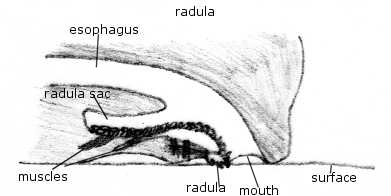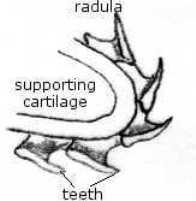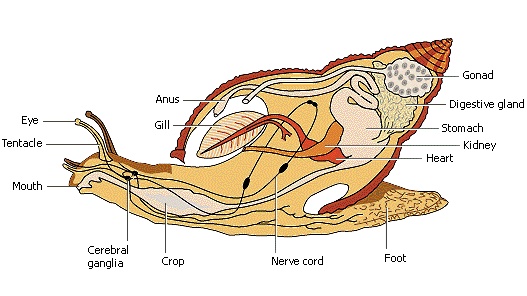Digestion and Feeding

The digestive tract of Pleurocera acuta includes a mouth, pharynx, esophagus, stomach,
small and large intestine, and anus
(Dazo, 1965). Accessory organs
include salivary glands, a radula, liver, and jaw
(Dazo, 1965).
Like many other Gastropods, Pleurocera acuta
is a herbivore feeding on decaying organic material and algae
(Hickman, 2009). To
acquire this material they use their radula. A radula is a chitinous, rasping, tongue-like organ that contains as many as
250,000 teeth that are used to scrape surfaces and in some
cases to spear prey (Dazo, 1965;
Hickman, 2009). 
The radula also acts like a conveyor
belt to transport food into the mouth by working rhythmically
with the odontophore cartilage
(Hickman, 2009). The feeding cycle begins
when the mouth opens, followed by the odontophore being pushed
forward while the radula strongly scrapes food against the
odontophore and into the pharynx
(Hickman, 2009). This motion, and the motion of
the supporting cartilage known as the odontophore is controlled
by nearby muscle bundles (Dazo, 1965;
Hickman 2009). These complex
structures are bright red due to the presence of Hemoglobin,
which is also found in the blood of humans
(Dazo, 1965).
Pleurocera acuta has a small jaw with left and right
parts that are made out of a chitin-like material
(Dazo,
1965). The chewing surface is often brown due to food
coloration and contains serrated scales for increased efficiency
(Dazo,
1965). The stomach is found in the second whorl of the
shell and has a specialized rod known as the style that is used for grinding
food like a pedal and mortar
(Dazo,
1965; Hickman 2011). This action is aided by the effects of
cellulase which digests cellulose, the main chemical component
of plants
(Dazo, 1965). The osphradium organ of Pleurocera acuta
is also an important digestive structure
(Dazo,
1965). According to
Dazo,
it was historically known to be a sensory organ but caused
confusion as to what it was sensing. It was finally determined
that it was a sensory organ responsible for sampling water
currents. The sampling input is used by the snail to determine
food selection
(Dazo,
1965).
Next Topic:
Reproduction
HOME
